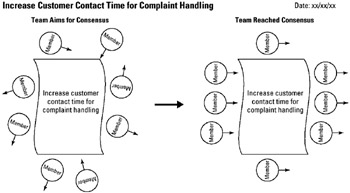Tool 39: Consensus Decision Making
| AKA | Consensus Generator |
| Classification | Decision Making (DM) |
Tool description
The consensus decision making tool is an interactive process in which all team participants openly communicate their ideas and reserve feedback and other points of view. The process continues until all team participants are able to accept and support a team decision even though some may not completely agree with it. Reaching consensus often requires greater individual participation, clear communication, and some compromise on well-considered decisions.
Typical application
-
To reach agreement on a proposed action or next step in a problem-solving effort.
-
To gain general agreement and support on a particular idea or issue.
-
To allow team participants the opportunity to express and defend their point of view.
-
To avoid conflict or rush to a decision.
Problem-solving phase
| → | Select and define problem or opportunity |
| → | Identify and analyze causes or potential change |
| → | Develop and plan possible solutions or change |
| Implement and evaluate solution or change | |
| Measure and report solution or change results | |
| → | Recognize and reward team efforts |
Typically used by
| Research/statistics | |
| 3 | Creativity/innovation |
| Engineering | |
| 2 | Project management |
| Manufacturing | |
| Marketing/sales | |
| Administration/documentation | |
| 4 | Servicing/support |
| Customer/quality metrics | |
| 1 | Change management |
before
-
Brainstorming
-
Brainwriting Pool
-
Futures Wheel
-
Affinity Diagram
-
Window Analysis
after
-
Team Process Assessment
-
Resource Requirements Matrix
-
Objectives Matrix (OMAX)
-
Responsibility Matrix
-
Action Plan
Notes and key points
-
Consensus is reached when:
-
All participants have presented their views.
-
Participants fully understand, accept, and will support the team decision.
-
Even if some participants are not fully satisfied or cannot completely agree with the decision, they do feel that they "can live with it" and will not oppose it.
-
Step-by-step procedure
-
STEP 1 The team displays a final list of ideas, a proposed problem solution, or process improvement activity. See example Increase Customer Contact Time for Complaint Handling.
-
STEP 2 Team participants clarify all issues, share views, and listen to other ideas or concerns. Ensure that all actively participate in this discussion.
-
STEP 3 After all information has been shared and alternatives considered, the team develops general agreement with care being taken to avoid conflict, participants taking sides, or outright blocking of compromise.
-
STEP 4 Lastly, the team creates a final decision statement and verifies that all participants understand and are willing to support their decision.
Example of tool application

EAN: 2147483647
Pages: 326